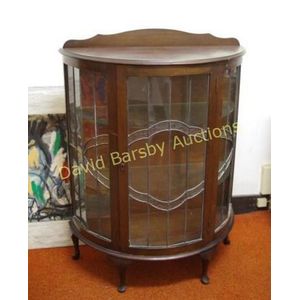French Kingwood Serpentine Credenza with Porcelain Plaques and Ormolu
A French kingwood serpentine credenza, 19th century, of serpentine bombe form with porcelain plaque insets and ormolu mounts, 112 cm x 195 cm x 50 cm
You must be a subscriber, and be logged in to view price and dealer details.
Subscribe Now to view actual auction price for this item
When you subscribe, you have the option of setting the currency in which to display prices to $Au, $US, $NZ or Stg.
This item has been sold, and the description, image and price are for reference purposes only.
- Ormolu - Ormolu was popular with French craftsmen in the 18th and 19th century for ornamental fittings for furniture, clocks and other decorative items. True ormolu is gilt bronze, that is bronze that has been coated with gold using a mercury amalgam. Due to the health risks associated with using mercury, this method of creating ormolu was discontinued in France in the 1830s. A substitute was developed consisting of about 75% copper and 25% zinc, however it was inferior to the bronze version. It was often lacquered to prevent it tarnishing.
- Bombe Front - More commonly associated with a dome shaped dessert, "bombe" in furniture parlance means "puffed out". In profile the piece is serpentine shaped, narrow at the top, swelling out towards the middle and continuing to the floor, though sometimes it narrowed again at the foot. Drawer fronts are curved in section. Bombe pieces are often highly decorated with marquetry inlay, or veneered and set with brass or ormolu mounts. The most common use of the word, is in the description of the 'bombe commode'.
The bombe design was particularly popular in the 18th century, during the reign of Louis XIV, when it was used to create furniture pieces with a curved, rounded bulging shape. This design was used on furniture in many styles, including Baroque, Louis XIV, Louis XV and Louis XVI. The bombe chest is one of the most iconic furniture piece featuring this design. They were usually made of precious woods like mahogany, rosewood, and walnut, and feature elaborate inlay, gilded ornaments and ormolu. Other items of furniture where the bombe design can be seen include cabinets, commodes, and desks. - Mounts - Mounts are used to describe bronze, brass and ormolu adornments on furniture especially quality furniture in the rococo and classical revival style, and are also the cabinet makers' name for the metal fittings on furniture, such as hinges, locks and handles, and metal edges and guards which protect furniture from damage.
- Serpentine - Resembling a serpent, in the form of an elongated 'S'. A serpentine front is similar to a bow front, except that the curve is shallow at each end, swelling towards the middle. The term presumably derives from its similarity to a moving snake or serpent. Serpentine fronts are usually veneered, with the carcase either being cut and shaped from a solid piece of timber, or built in the 'brick' method.
This item has been included into following indexes:
Visually similar items

Fine vintage English mahaogany Georgian style display cabinet, fitted with three central drawers below and cupboards tot he sides, glazed sepertine top, approx 197 cm high, 140 cm wide, 50 cm depth
Sold by
in
for
You can display prices in $Au, $US, $NZ or Stg.

Vintage Chippendale style china cabinet 101 cm wide, 150.5 cm high
Sold by
in
for
You can display prices in $Au, $US, $NZ or Stg.

Vintage leadlight china cabinet, 90 cm wide, 121 cm high
Sold by
in
for
You can display prices in $Au, $US, $NZ or Stg.

Victorian mahogany glasstop bookcase with two lower doors and single drawer
Sold by
in
for
You can display prices in $Au, $US, $NZ or Stg.
